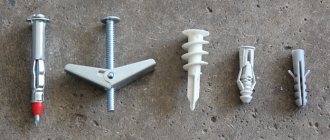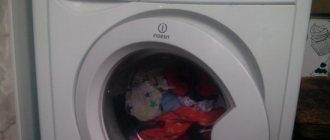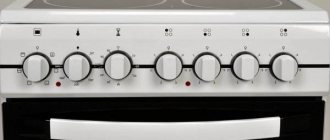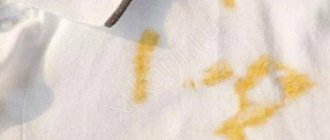Food is prepared on the kitchen stove every day. Most often, housewives touch handles and switches. We touch it in a hurry with a dirty hand, then when we fry, splashes of fat fly in different directions, dirtying our hands, or the milk runs away.
As a result, dirt and grease become clogged in small cracks, dents and crevices. Attempts to wash these stains with a sponge and detergent end in vain. And how do you clean it all up?
In this article, you will learn about cleaning methods in different ways, depending on the type of pens, the degree of contamination and affordability. You will learn which household chemicals are suitable for you, as well as some effective recipes that you can prepare at home yourself.
Methods for cleaning pens depending on the type
If the regulators are easily removed, they can be soaked or boiled in a solution to remove grease, and then easily clean off the residue with a brush.
If the handles on your stove are not removable, do not be upset, and for this case there will be a way; in this situation, sticks with cotton wool, again a toothbrush, which is no longer suitable for brushing teeth, gauze swabs and toothpicks are quite suitable for helping us.
Cleaning of fixed handles is carried out in the following sequence:
- take a product that contains chlorine;
- moisten a gauze swab in it and apply it to the hands (or spray it with a spray bottle);
- wait a few minutes;
- Next, we take a brush and clean it, in hard-to-reach places we go through with a cotton swab and a toothpick;
- Afterwards, use a sponge or cloth to wipe away any remaining dirt.
Removable and non-removable handles - cleaning rules
Determining which regulators are on your gas stove is not difficult. If, by slightly pulling the handle towards you, it is removed, then you can rest assured that the switches are removable. If you make an effort, turn the handle in all directions, pull towards yourself with all your might, but it does not give in - alas, the regulator is not removable. In this case, do not try to forcefully disconnect the regulator so as not to inadvertently break it.
So, two types of stove handles and options for cleaning them.
Removable handle
Cleaning dirt from the removable handle is not a troublesome task. If the regulators are removed, then proceed as follows. Remove all switches. Prepare a container with hot water (about 80 °C). Dissolve grated laundry soap, washing powder or dishwashing detergent in hot water. Place all handles in soapy water for 15 minutes. Then, arm yourself with an old toothbrush and try to thoroughly clean the entire switch, outside and back. The regulators of the gas stove will sparkle with cleanliness.
Fixed handle
With regulators that are tightly attached to the hob, it will be more difficult. It is almost impossible to clean the handles on the inside, but on the outside it is quite possible. The following will come to help: cotton swabs, cotton swabs, toothpicks, a toothbrush. Lightly wet the handles and clean hard-to-reach places from dirt with a toothpick. Absorb any remaining dirt around the switches with cotton swabs. Using a cotton swab soaked in chlorine detergent, thoroughly clean the regulators. Then rinse off the product with warm water using a sponge.
Top 5 folk remedies for removing dirt from stove handles
The household goods department sells many powders, gels, and solutions that effectively dissolve dirt and grease from any surface. The price of these miracle jars is high, but there is no guarantee that this product will help wash your hands. Before emptying your wallet, try “penny” products that have been tried and tested by the people and cope with stains no worse than store-bought and expensive chemicals.
Ammonia
There is a bottle of ammonia in every first aid kit. Ammonium hydroxide is surprisingly good at cleaning stains from furniture, dishes, bathroom fixtures, and even jewelry. Speaking about how to clean the handles of the stove, take note: you need to use not pure ammonia, but drops called “ammonia-anise”. Inhaling ammonia vapor from ammonia can cause poisoning. The drops are safe - they don’t even need to be diluted. We wet the cotton wool with drops and wipe the dirty regulators. In hard-to-reach places, clean with a cotton swab dipped in drops. If you plan to wash your pens with alcohol, then use a diluted solution with water in a 1:1 ratio.
Lemon juice
Concentrated lemon juice dissolves any dirt. Squeeze the juice of 1 lemon. Prepare an unnecessary toothbrush. Dipping a brush into lemon juice, thoroughly clean the surface of the stove's regulators in areas of contamination. If the switch is so dirty that there are many small greasy spots on it that cannot be washed off, then dip the brush in baking soda (not baking soda!) and lightly rub the problem area. Dip the brush alternately in sour juice and soda to completely clean the handles. At the end of the handle, rinse with a sponge and clean water to remove the stickiness of the juice and any remaining soda.
Wet wipes
Sometimes, in order to clean the handles, it is enough to wipe them several times with wet wipes. Many wet wipes contain castor oil and citric acid, which effectively remove dirt. This is a gentle cleaning method for both the gas stove controls and your hands. After wrapping a damp cloth around your finger, carefully treat and wipe the surface of the handles. Change the napkin when it gets dirty. After cleaning, wipe the stove switches dry with a clean cloth.
Vinegar
Using vinegar is only suitable for removable stove handles. It will dissolve strong corrosive contaminants, eliminate bacteria and unpleasant odors. Remove the regulators and place them in a small saucepan or ladle. Mix 200 ml of vinegar and 700 ml of water. Fill the handles with the solution. Place over medium heat and bring to a boil. Boil for 7-10 minutes. Drain the water into the sink and let the switches cool. Dry and wipe dry, place back on the stove panel.
Laundry soap
A strong soap solution made from laundry soap will clean your handles well from greasy sticky stains and dirt. Grate 50 g of soap on a fine grater. Mix with 100 ml of boiling water. If the regulators are removable, then they should be soaked in soapy water overnight. After 8-10 hours, wipe them with a sponge and rinse in clean water. Fixed handles should be cleaned using the hard side of a sponge. Dip the sponge into the solution to wash off the dirt. After cleaning, wipe the handles with a damp cloth and let them dry completely. If your stove is plugged in, disconnect it from the power supply before cleaning. Wipe the handles after each cooking, then dirt will not accumulate on them, and your stove will always be clean and tidy.
Click “Like” and receive only the best posts on Facebook ↓
Source
Types of pollution
Housewives in the kitchen most often have to deal with two types of dirty handles:
Light soiling of handles
If you pay attention to cleaning the handles and the entire stove after each cooking, keep your hands clean, and wipe off grease and burnt food in a timely manner, then the stains will be light and washing them will not be difficult.
ingrained fat
It happens that for various reasons, it is not possible to wash the handles and stove immediately after cooking, then the fat eats into the surface, and here other methods are needed.
What products should I use to quickly clean stove handles?
For quick cleaning of handles, special wipes are suitable. They contain alcohol and citric acid, which successfully remove fat.
This also includes a spray product that you can buy in a store or prepare at home.
You can also use window cleaner by spraying the handles and then wiping them with a dry cloth. When using this method, the solution gets into hard-to-reach places, dissolving fat.
How to clean the handles of a gas stove with vinegar?
Every housewife has vinegar in her arsenal and is an excellent helper in the kitchen. With its help you can perform a lot of cleansing manipulations. This includes cleaning the handles of the gas stove with vinegar to remove grease soot.
Instructions:
- Take an old toothbrush and soak it in vinegar. Rub the stain thoroughly and rinse off with warm water. It is worth noting that the best way to clean dirt from grease soot is prevention.
- After each cooking, it is necessary to wipe the hob, as well as the controls, with ordinary soapy water. You can use glass cleaner. It usually contains alcohol, or ammonia.
- These aggressive products do an excellent job of removing dirt. In addition, you can protect the surface using special covers on the hob. These are foil coverings and mats that are laid out on top of the hob.
- The main advantage is that they are reusable and can be washed under running warm water. More information about covers for gas stoves can be found here.
- Try to carry out general cleaning from time to time and clean the regulators using aggressive agents.
Cleaning agent
Folk remedies
There are many grandmother's remedies that can be prepared at home from the most ordinary materials. They can always be found in almost every home.
Lemon juice
After processing this method, a pleasant lemon aroma will remain in the kitchen. We work with the use of this representative of citrus crops in the following sequence:
- We take one lemon, squeeze the juice out of it, then take a toothbrush (which we will no longer use to clean our teeth) and, dipping as necessary, clean our hands in a circular motion.
- If after this the dirt remains, additionally take baking soda and alternately dip it in juice and then in soda and clean off the remains.
- Afterwards, wash with a damp cloth or sponge and rub with a dry towel.
Important!
It is advisable to apply the solution in this way quickly while the quenching process is taking place.
Vinegar will get rid of odors and remove dangerous bacteria.
If the handles are removable, add a solution of equal proportions of water and vinegar in a saucepan, carefully remove the handles from the stove, lower them into the diluted liquid and put them on medium heat, bring to a boil and boil for 6-8 minutes. Then remove, cool and rub with a towel until dry. We install it in place.
If the handles are not removable, then in a spray bottle you need to dilute the composition of one part vinegar plus one part water, spray the handles generously, wait a while, and then wipe them with a clean, dry towel or paper napkin.
Laundry soap
For removable regulators, the following method is suitable:
- take a basin or large saucepan (the main thing is that everything fits there);
- rub laundry soap on a coarse grater into our container, fill it with hot water (about 80 degrees);
- stir until the soap dissolves (dishwashing detergent, washing powder);
- carefully lower our hands into the resulting solution and hold for 20-30 minutes (depending on the degree of contamination);
- then, after the time has passed, we find an unnecessary toothbrush and carefully clean the regulators on all sides and rinse with water.
After such cleaning, the removable regulators will again sparkle like new.
Advice!
If the contamination is very heavy, the soaking process should be increased to 10 hours.
This solution can also be used for handles that are not removable. To do this, use the non-soft side of the sponge, after applying the solution to it, and thoroughly rub the stained areas. And then remove the residue with a rag or paper towel.
Ammonia
This drug will help remove very strong and old stains if you work in the following sequence:
- dilute one part of water with one part of ammonia;
- dip a gauze swab and apply the product to the surface; We treat hard-to-reach places with a cotton swab and toothpick;
- wait a few seconds and wash off any remaining dirt with a clean, damp cloth.
Advice!
You can also use ammonia to clean furniture, dishes, taps in the kitchen and bathroom, and even items made of precious metals. It is advisable to carry out cleaning with this product while wearing a mask so as not to be poisoned by its vapors.
Instructions for removing the handle
Since most modern cookers have removable power controls, they can be easily removed for cleaning. But, if this has not been done before, then rough oiling can create certain difficulties. Despite this, the cleaning operation is still worth carrying out.
It is important not to forget that the stove is a gas-using equipment, during the operation and maintenance of which it is important to comply with fire safety rules. Therefore, before starting to work with the stove, it is necessary to turn off the gas supply, since any manipulations are considered flammable.
To carry out the work you need to prepare the following:
- gloves;
- gas key;
- pliers;
- screwdriver;
- knife;
- rags;
- water and detergent.
According to safety requirements, work must be carried out with rubber gloves.
Some models of gas stoves have special mounts for handles. You need to remove them carefully so as not to damage the thread and then return them to their place.
A gas wrench, pliers and a screwdriver will be needed to remove the gas stove handle, while a toothbrush and detergent will be needed to clear clogged areas. It is worth remembering that different models of gas stoves have different methods for removing handles.
You should start working after the gas supply valve is closed.
We suggest you read How to make a console table with your own hands
The gas stove knobs should be set to the “Off” position. In order to remove one handle, you need to pull it towards you and slowly pull it out of the groove. This operation must be carried out very carefully so as not to damage the rotating mechanism.
If you cannot remove the handle manually, you can use pliers. Using the rag as a spacer between the handle and the working surface with part of the pliers, gently squeezing and pulling
In some types of stoves, the handles are screwed on with screws; you need to use a screwdriver to unscrew them. There are also options when you can remove the handle by lifting the mounting protective cap. When using a screwdriver or knife to pry up the handle, you should act extremely carefully so as not to damage the surface of the stove.
There are models where the protective ring has grooves, and in order to get it out, you just need to twist the ring a little to the side.
To clean dismantled handles, you need to prepare a container with warm water and detergent in which to place all removable mechanisms that need cleaning. Keep it in the washing solution for at least 10 minutes, and in case of severe contamination, change the water additionally.
To clean the surface of the handles, do not use substances containing chlorine, as this can damage the enamel coating and erase the inscriptions on the handle.
Using a brush, you should carefully remove dirt from the areas of the stove where the handles were installed. Pay special attention to notches, gaps and reliefs.
It is worth noting that when processing aluminum parts of the handles, it is better to use a rag moistened with vegetable oil, and then remove any remaining oil with a detergent containing alcohol
Also, when cleaning the surface of the stove and hard-to-reach places under the handles, do not forget about the grate. It also requires timely maintenance.
To effectively clean grates made of various materials, various methods and available means are used.
The handles are installed after all parts have completely dried. It is necessary to correctly put all the rotating mechanisms in their original places. If the handle shaft is not fully seated in the groove, it will not work.
The handles of gas stoves come in plastic and metal. They are equally heat resistant, however, when removing and installing a plastic handle, the likelihood of damage is much higher
Each model has its own order. For example, to remove the handle from the Hephaestus plate, you need to do the following:
- First, shut off the gas access with the valve.
- In order to adhere to safety rules, you should make sure that all controls are disabled.
- Next, take the knife and pry off the handle along with the circle where the marks are shown. In this case, you can apply a little force.
For “Darina” there is a slightly different method.
- Just as in the first step, the primary step is to shut off the gas to ensure there is no danger.
- Then you need to disconnect the hose connected to the kitchen unit.
- Turn off all possible control valves. Otherwise, there is a risk of damage.
- Next, wrap these products with a piece of any fabric and lightly pry them with some object.
- It is best to remove with pliers. If they are not there, then two knives will be suitable and will also be able to do the job. The important point is to carefully complete all steps. If you move it awkwardly or incorrectly, the surrounding components of the device may be damaged due to their fragile nature.
And the last brand we’ll look at is Hansa.
- The second step is to remove the handles using a small screwdriver.
- Next you need to pry off the washer, as in the others. The main thing is to do it with marks.
- And carefully pull the product towards you.
We suggest you familiarize yourself with the indesit stove, how to turn on the oven
IMPORTANT!
Whenever manipulating the stove, be sure to turn off the gas first, since the equipment itself is flammable.
As has already become clear, all actions take place without the slightest difficulty. They can only occur when fat has accumulated or oil has frozen inside.
Household chemicals
For those who are used to buying cleaning products and detergents in household chemical stores, there is a huge variety and choice.
Household chemicals consist of various alkalis and solvents with the addition of soap and other ingredients. When using these tools, you should also not forget about the safety measures, which include the following:
- work with gloves;
- strictly follow the instructions;
- ventilate the room after treatment.
It is worth thinking before buying products in a store, as they are more expensive and not as effective as homemade products.
Adviсe
- You can quickly clean and restore the glossy shine of the regulator by mixing a couple of teaspoons of soda with a small amount of 3% hydrogen peroxide to the consistency of a thick paste. Apply the mixture to the handles using a toothbrush; after 5-7 minutes, carefully and effortlessly clean the parts with a brush and wipe with a damp cloth. This method will also help remove yellowness from white elements.
- Salicylic acid (1%) is effective in removing even the most stubborn grease stains. Soak a cotton pad or cotton swab in the preparation and thoroughly clean the regulators. After treatment, wipe the handles with a dry cloth.
- You can remove deposits and stains from plastic parts or the touch panel using a glass cleaner: spray the mixture onto the surface, after a minute wipe off the product and softened grease with a damp sponge.
IMPORTANT! Proper operation of the stove, maintaining the cleanliness of switches and the entire device as a whole directly affects the service life of household appliances.
Never forget about the main rule, the observance of which will help you always keep your equipment in perfect order: it is easier to spend three minutes wiping surfaces with a damp sponge after cooking than to wash parts stuck with grease for several hours.
How to keep your pens always clean
To ensure that the control knobs are always clean and last longer, also to prevent the accumulation of germs, regularly, after each preparation of food, wipe them with special napkins or a damp cloth, dipping it in a detergent or cleaner, and keep your hands clean.
Choose the product that suits you best, follow our recommendations and do not forget about precautions. And let cooking bring you only joy and pleasure.











